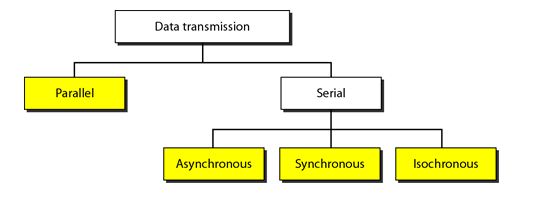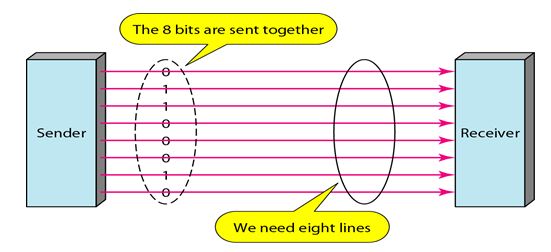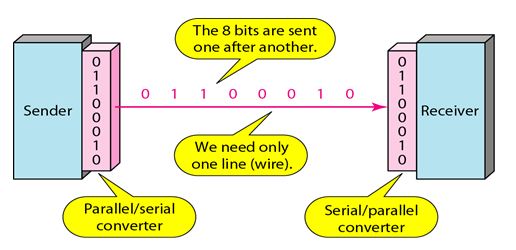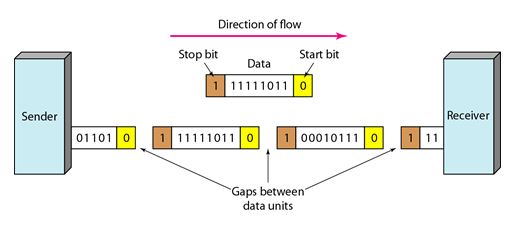Different Transmission Modes
The primary concern in the transmission of data from one device to another is the wiring and how to send the data stream. Do we send 1 bit at a time or group bits into larger groups. The transmission of binary data across a link can be accomplished in either parallel or serial mode. In parallel mode, multiple bits are sent with each clock tick. In serial mode, 1 bit is sent with each clock tick. The different transmission modes are as shown in the following figure.
I. Parallel Transmission:
In Parallel Transmission, data consisting of 1s and 0s, may be organized into groups of n bits each. Computers produce and consume data in groups of bits. By grouping, we can send data n bits at a time instead of 1bit. This is called parallel transmission.
In parallel transmission we use n wires to send n bits at one time. That way each bit has its own wire, and all n bits of one group can be transmitted with each clock tick from one device to another. The following figure shows how parallel transmission works for n =8. Typically, the eight wires are bundled in a cable with a connector at each end.
The advantage of parallel transmission is speed. All else being equal, parallel transmission can increase the transfer speed by a factor of n over serial transmission. But the disadvantage is cost. Parallel transmission requires n communication lines just to transmit the data stream. Because this is expensive, parallel transmission is usually limited to short distances.
You May Also Like:
Line Coding and Its Characteristics
Different Line Coding Techniques
Different Block Coding Techniques
II. Serial Transmission
In serial transmission one bit follows another, so we need only one communication channel rather than n to transmit data between two communicating devices. The following figure shows serial transmission.
The advantage of serial over parallel transmission is that with only one communication channel, serial transmission reduces the cost of transmission over parallel by roughly a factor of n. Serial transmission occurs in one of three ways: asynchronous, synchronous, and isochronous.
a). Asynchronous Transmission:
In Asynchronous transmission, the timing of a signal is unimportant. Instead, information is received and translated by agreed upon patterns. As long as those patterns are followed, the receiving device can retrieve the information without regard to the rhythm in which it is sent. Patterns are based on grouping the bit stream into bytes. Each group, usually 8 bits, is sent along the link as a unit. The sending system handles each group independently, relaying it to the link whenever ready, without regard to a timer.
Without synchronization, the receiver cannot use timing to predict when the next group will arrive. To alert the receiver to the arrival of a new group, therefore, an extra bit is added to the beginning of each byte. This bit, usually a 0, is called the start bit. To let the receiver know that the byte is finished, 1 or more additional bits are appended to the end of the byte. These bits, usually 1 s, are called stop bits.
By this method, each byte is increased in size to at least 10 bits, of which 8 bits is information and 2 bits or more are signals to the receiver. In addition, the transmission of each byte may then be followed by a gap of varying duration. This gap can be represented either by an idle channel or by a stream of additional stop bits. The start and stop bits and the gap alert the receiver to the beginning and end of each byte and allow it to synchronize with the data stream.
This mechanism is called asynchronous because, at the byte level, the sender and receiver do not have to be synchronized. But within each byte, the receiver must still be synchronized with the incoming bit stream. That is, some synchronization is required, but only for the duration of a single byte. The receiving device resynchronizes at the onset of each new byte.
When the receiver detects a start bit, it sets a timer and begins counting bits as they come in. After n bits, the receiver looks for a stop bit. As soon as it detects the stop bit, it waits until it detects the next start bit.
The following figure is a schematic illustration of asynchronous transmission. In this example, the start bits are as, the stop bits are 1s, and the gap is represented by an idle line rather than by additional stop bits.
The addition of stop and start bits and the insertion of gaps into the bit stream make asynchronous transmission slower than forms of transmission that can operate without the addition of control information.
b). Synchronous Transmission:
In synchronous transmission, the bit stream is combined into longer "frames," which may contain multiple bytes. Each byte, however, is introduced onto the transmission link without a gap between it and the next one. It is left to the receiver to separate the bit stream into bytes for decoding purposes.
The following figure show illustration of synchronous transmission.
The sender puts its data onto the line as one long string. If the sender wishes to send data in separate bursts, the gaps between bursts must be filled with a special sequence of 0s and 1s that means idle. The receiver counts the bits as they arrive and groups them in 8-bit units.
Without gaps and start and stop bits, there is no built-in mechanism to help the receiving device adjust its bit synchronization midstream. Timing becomes very important, therefore, because the accuracy of the received information is completely dependent on the ability of the receiving device to keep an accurate count of the bits as they come in.
The advantage of synchronous transmission is speed. With no extra bits or gaps to introduce at the sending end and remove at the receiving end, and, by extension, with fewer bits to move across the link, synchronous transmission is faster than asynchronous transmission. For this reason, it is more useful for high-speed applications such as the transmission of data from one computer to another.
c. Isochronous:
In real-time audio and video, in which uneven delays between frames are not acceptable, synchronous transmission fails. For example, TV images are broadcast at the rate of 30 images per second; they must be viewed at the same rate. If each image is sent by using one or more frames, there should be no delays between frames. For this type of application, synchronization between characters is not enough; the entire stream of bits must be synchronized. The isochronous transmission guarantees that the data arrive at a fixed rate.
You May Also Like:
Different Scrambling Techniques
Analog to Digital Conversion Techniques
Back to DCN Questions and Answers




